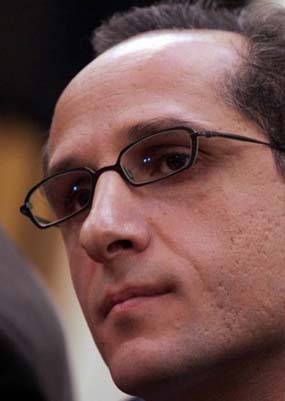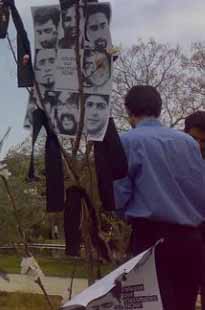| Home > 30 years human rights in Iran > Interview > An Interview with Hadi Ghaemi, the spokesman for the International Campaign of Human Rights in Iran (Part 1 ) | |||
An Interview with Hadi Ghaemi, the spokesman for the International Campaign of Human Rights in Iran (Part 1 ) An Interview with Hadi Ghaemi, the spokesman for the International Campaign of Human Rights in Iran (Part 1 ) By Ardavan Rouzbeh a.roozbeh@radiozamaneh.comNote: As part of our special series, “Human Rights in Iran: Thirty Years,” RADIO ZAMANEH has been conducting interviews with leading human rights experts and activists. In this interview, RADIO ZAMANEH seeks to clarify whether human and civil rights are defined differently outside of Iran and whether human rights violations in Iran have been of a systematic nature over the past three decades. Hadi Ghaemi is a human rights activist whose work in the past few years has focused specifically on issues related to human rights violations. He is currently the coordinator of the International Campaign for Human Rights in Iran. Previously, he served as a Human Rights Watch analyst for Iran and the United Arab Emirates (UAE). Ghaemi’s reports on the violation of rights of immigrant laborers in the UAE proved highly effective on the policies of the UAE government.
From 2000 to 2004, Ghaemi worked with a number of NGOs to expose human rights violations in Iraq and Afghanistan. In 2003, he received a research scholarship from the MacArthur Foundation. He is a graduate of Boston University and until 2000 he was a professor of physics at New York University.
In a lengthy two-part interview conducted in the studios of RADIO ZAMANEH, Ghaemi discussed the issue of human rights in Iran from several perspectives.
Q. Is human rights defined and understood differently in Iran from the rest of the world? Is the definition of human rights in the international community different from the “rights of citizens,” as interpreted in Iran?
A. There isn’t that much of a difference. It has just been renamed in Iran. The “rights of citizens” legislation, which was submitted by the Judiciary to the Majlis [parliament] and subsequently approved by parliament, is about respecting the rights of the people, just as human rights is [by definition]. For example, “human rights,” as defined at an international level, and the “rights of citizens,” as defined in Iran both prohibit torture. Of course some of the wording and details may be different. However, the main point isn’t whether human rights are protected under the Constitution and various legislation, but whether human rights are respected on the streets of Iran and in everyday life. Unfortunately, the fact is that human rights are violated in Iran repeatedly on a daily basis. There are dozens of such violations reported each and every day. For ordinary working class Iranians, these violations are even more harsh and prevalent. For the police, security forces, the Judiciary, and others, violating human rights has virtually become a habit or second nature. For instance, the first thing any detained suspect experiences is physical and emotional torture and mistreatment with the aim of obtaining a confession. Because once the accused confesses, the job of the interrogator and prosecutor becomes much easier and they can move to the next stage. The kind of rigorous and professional interrogation that take place in many advanced countries in order to ascertain the facts of a case, do not take place in Iran.
Q. Do you believe these violations are systematic in nature?
A. Yes. But more generally, it depends. In instances where intelligence and security forces are involved, it is definitely systematic.
Q. How is it they can so blatantly violate human rights and expect no retribution?
A. For two reasons: Lack of transparency and lack of accountability. In the reformist Sixth Majlis, there were considerable efforts by lawmakers to introduce oversight. An example is the commendable work done by the parliament’s Article 90 Commission. But right now there is no political will within the government and the Islamic system to rein in these violations. Regarding transparency, just look at the number of executions carried out in Iran each and every year and the manner in which the accused is indicted, put on trial and sentenced. It has attracted so much attention and negative media coverage. We don’t even know how many people are executed in Iran each year. Because the Supreme Court -- the body which ultimately approves executions and should provide statistics on the number of executions in the country-- is wholly unaccountable on this issue. With such an utter lack of transparency and accountability, how can one expect an interrogator or an intelligence/security official to restrain his behavior?
Q. Such violations were much more severe in the 1980s. Why isn’t there more debate about those years? Why is there just talk about the recent violations?
A. This is a key and crucial question. I believe the killings and mass executions that took place in the prisons of the Islamic Republic in the 1980s were the most notorious and egregious in the history of Iran. People were jailed on the flimsiest of charges and remained incarcerated for many years. It can confidently be said that since the inception of the Pahlavi dynasty, the 1980s were the bloodiest as far as human rights crimes are concerned. The harshest and most outrageous violations of human rights took place in that decade. Thousands and thousands of people were killed. Most people in Iran today have little or no memory of those terrible crimes. After all, a majority of Iranians are under the age of 35. But for members of the older generation like myself, those wounds are still very much open. The ruling establishment has tried very hard to erase and wipe away any evidence or reference to those horrendous mass executions. The main reason those killings did occur in the first place was due to a lack of transparency and accountability.
Hadi Ghaemi, the spokesman for the International Campaign of Human Rights in Iran We all have to direct more and more of people's attention to what happened in the 1980's. Of course for activists this creates two problems. One is that human rights organizations have to follow up and raise awareness of new violations, which are numerous and take place many times each and every day. And the other problem is a scarcity of evidence to prove the atrocities committed back then. That is not to say there aren’t witnesses still living or that there is no tangible evidence to prove they took place.
Q. What I meant by my last question was why couldn’t any action be taken back then to protect human rights?
A. I have to divide my answer between the pre- and post-revolutionary eras. In the immediate period before the revolution, the human rights issue was one of major significance to the revolutionaries. In 1976, with Jimmy Carter’s ascendancy to the presidency of the United States, human rights issues came to the forefront. It became a core issue. In fact, the first cracks in the regime took place as a consequence of the criticisms leveled by the Carter administration at the Shah’s human rights record. The Shah’s opponents, especially activists, took full advantage of the atmosphere created. They embarked on a campaign to expose violations. They fought to secure the release of political prisoners. However, in the immediate aftermath of the revolution, there was a huge crackdown on these same activists. The actions of the revolutionary government against activists, dissidents and others were quite vicious. It resulted in an armed resistance. The regime’s response was to exert more brutal force, perform mass executions and to totally crack down on anyone who dared raise his or her voice against human rights offenses. When Iraq invaded Iran, the walls closed in even more. The regime did not tolerate any dissent or opposition. There was absolutely no discussion of human rights in those years. The country was at war and the economy was under enormous stress; the revolutionary government had no stomach for any criticism whatsoever. When mass executions were taking place, nobody in Iran dared to discuss them. Foreign-based media reported on it a few months after the fact and the news eventually trickled back into the country from abroad. Of course the families of the victims knew, but there was no civil society organization at the time to relay the news. Though small, civil society in Iran today is much stronger and active than anything that existed in the 1980's. The press and media were much more under state control. There was no Internet. It was almost impossible to get news and even more impossible to talk or do anything about it. |
|||
 |













